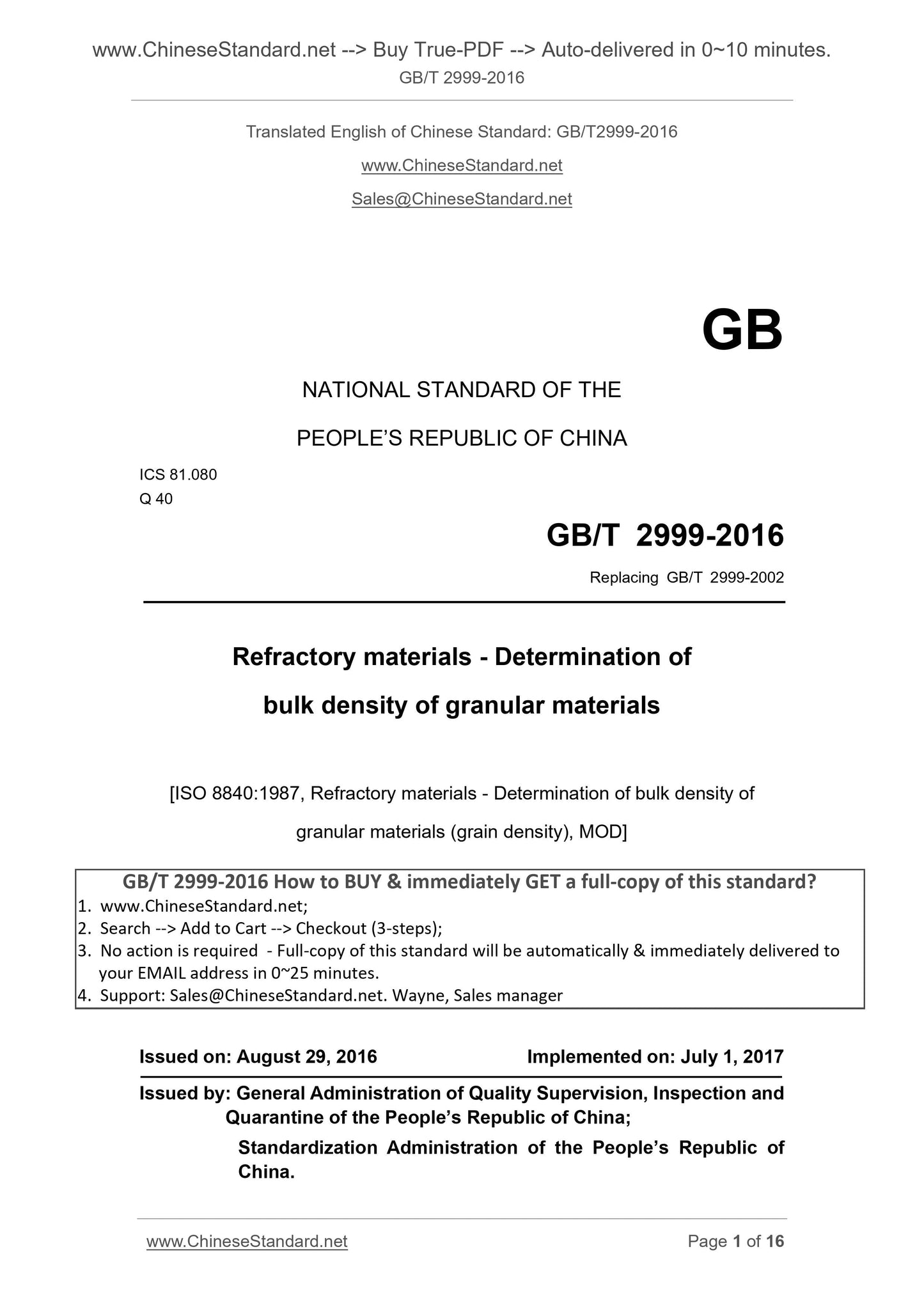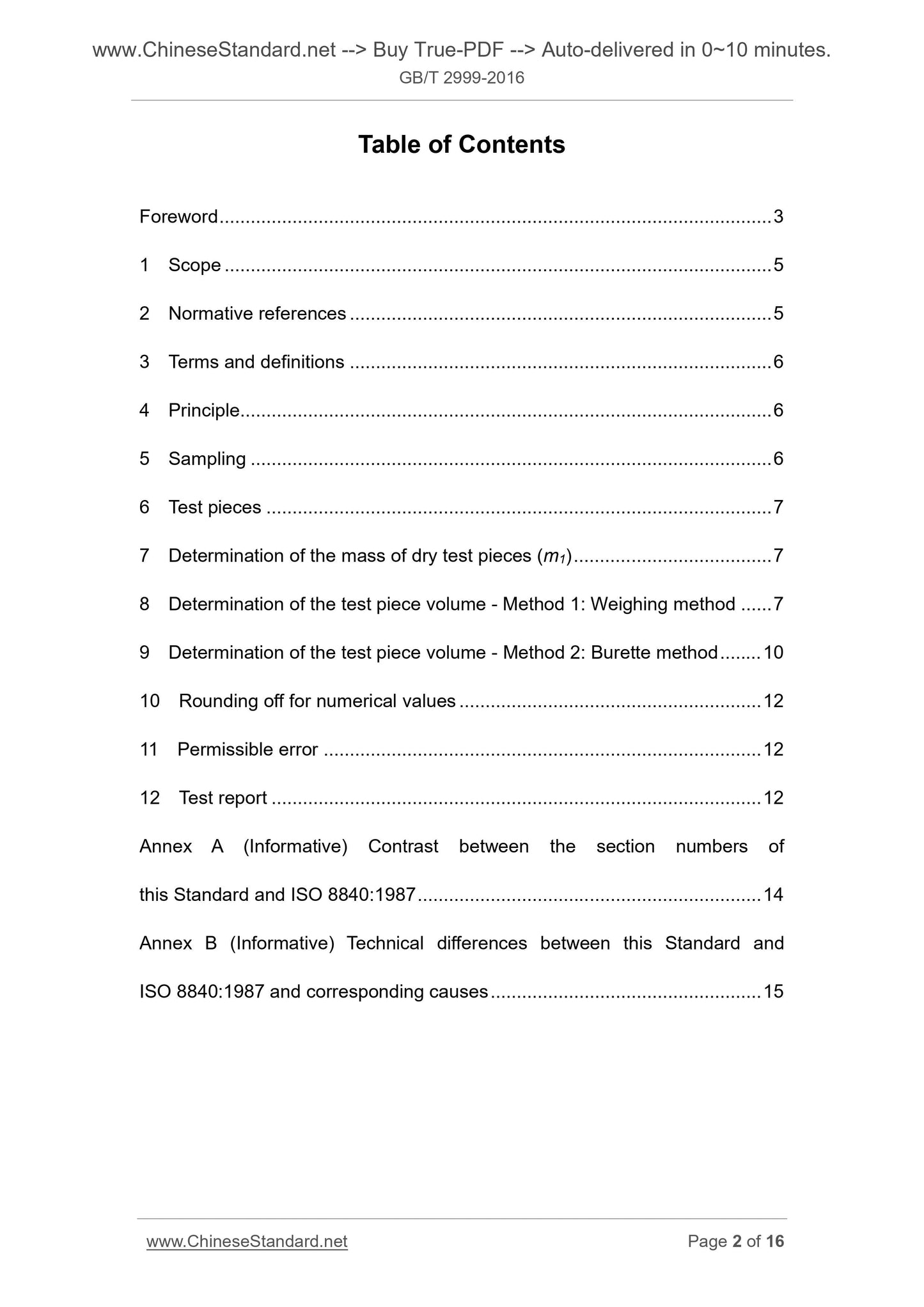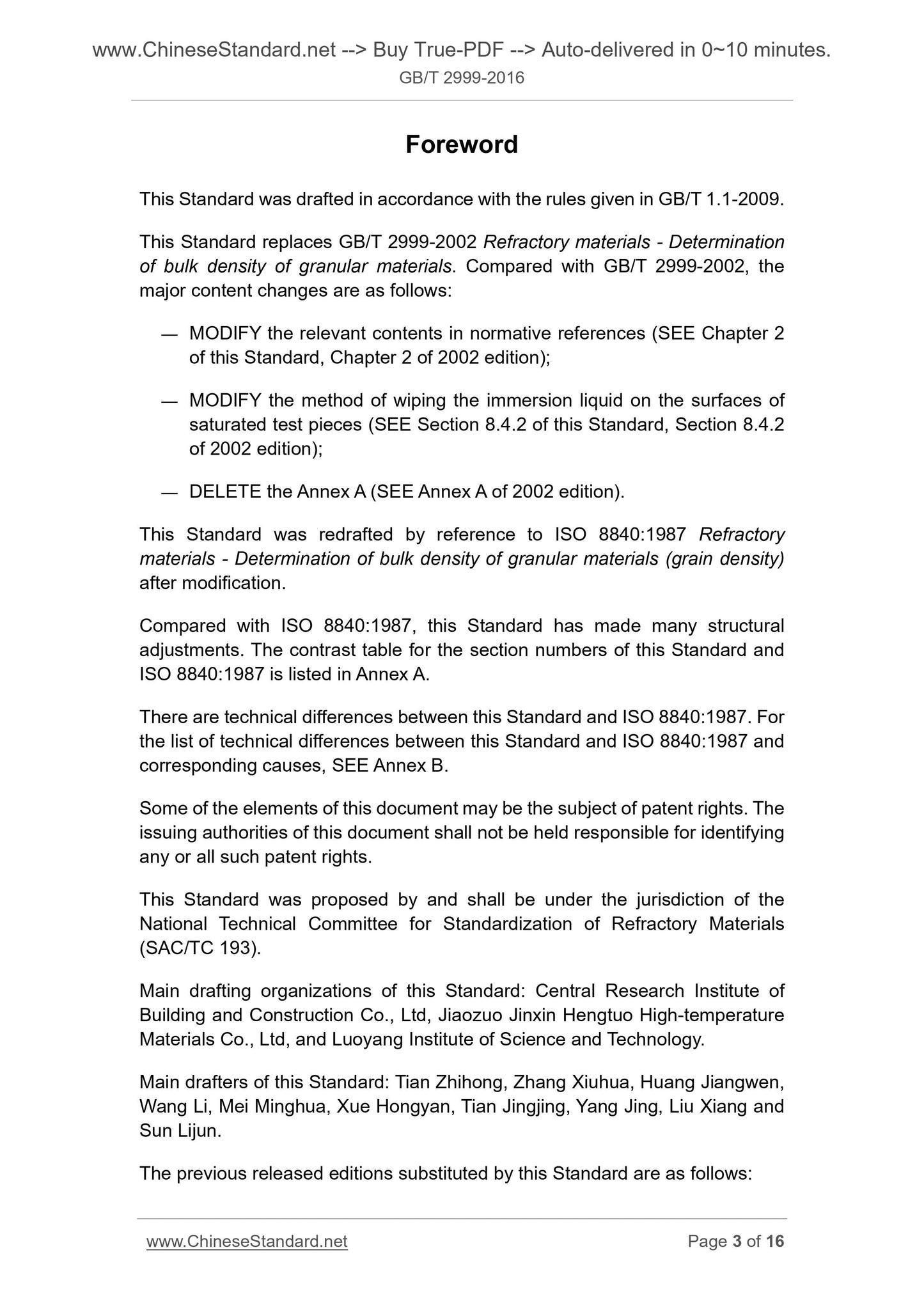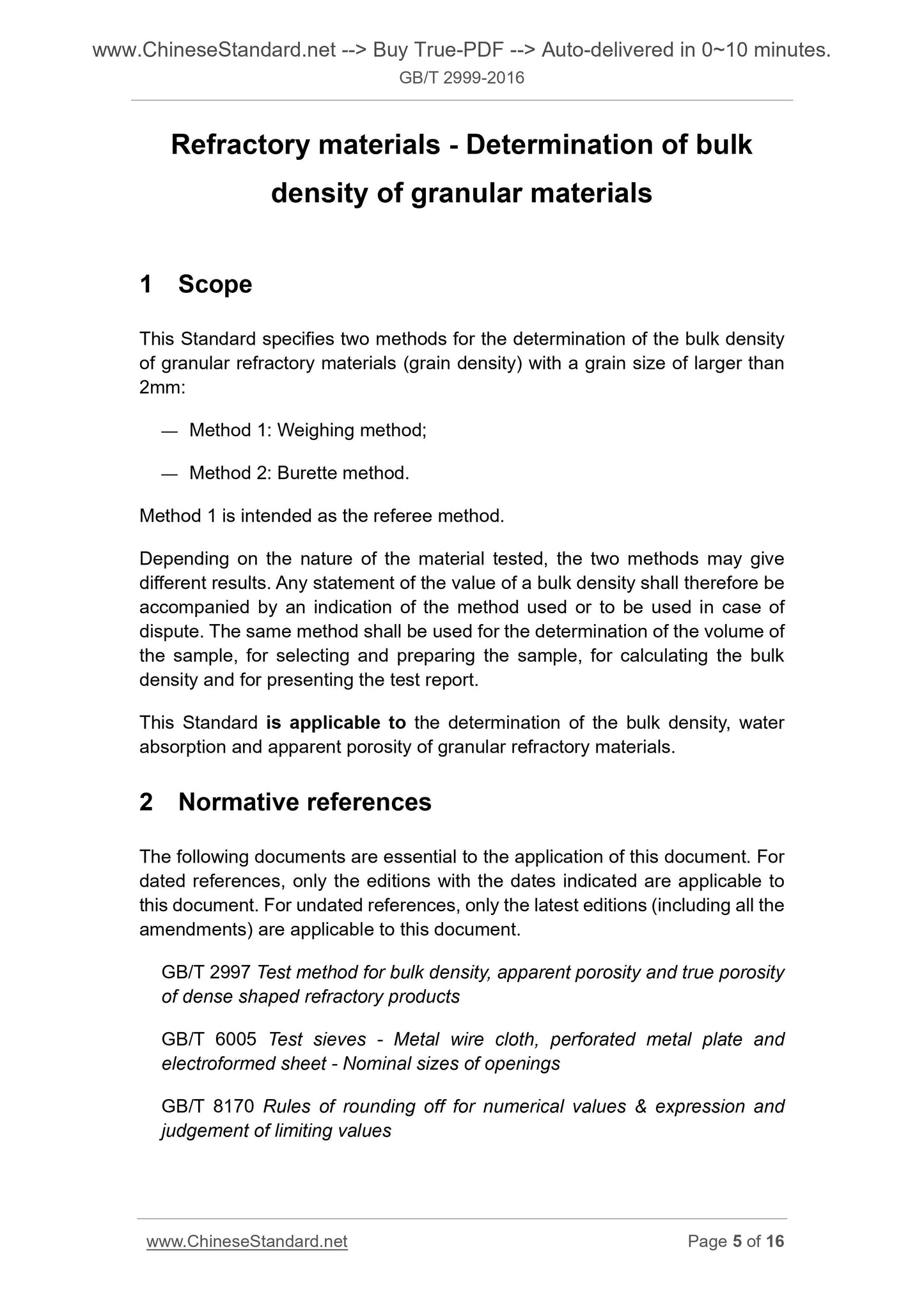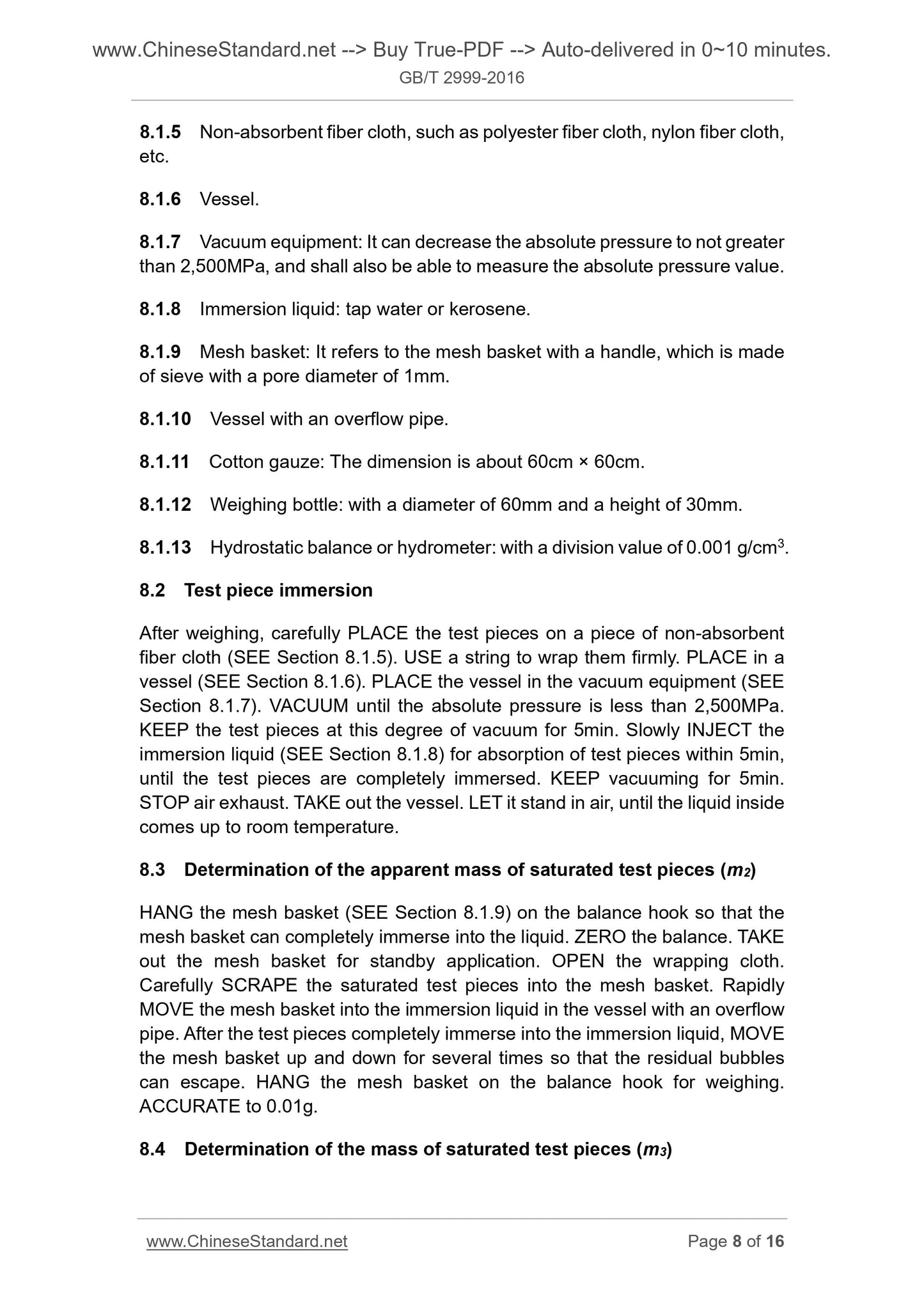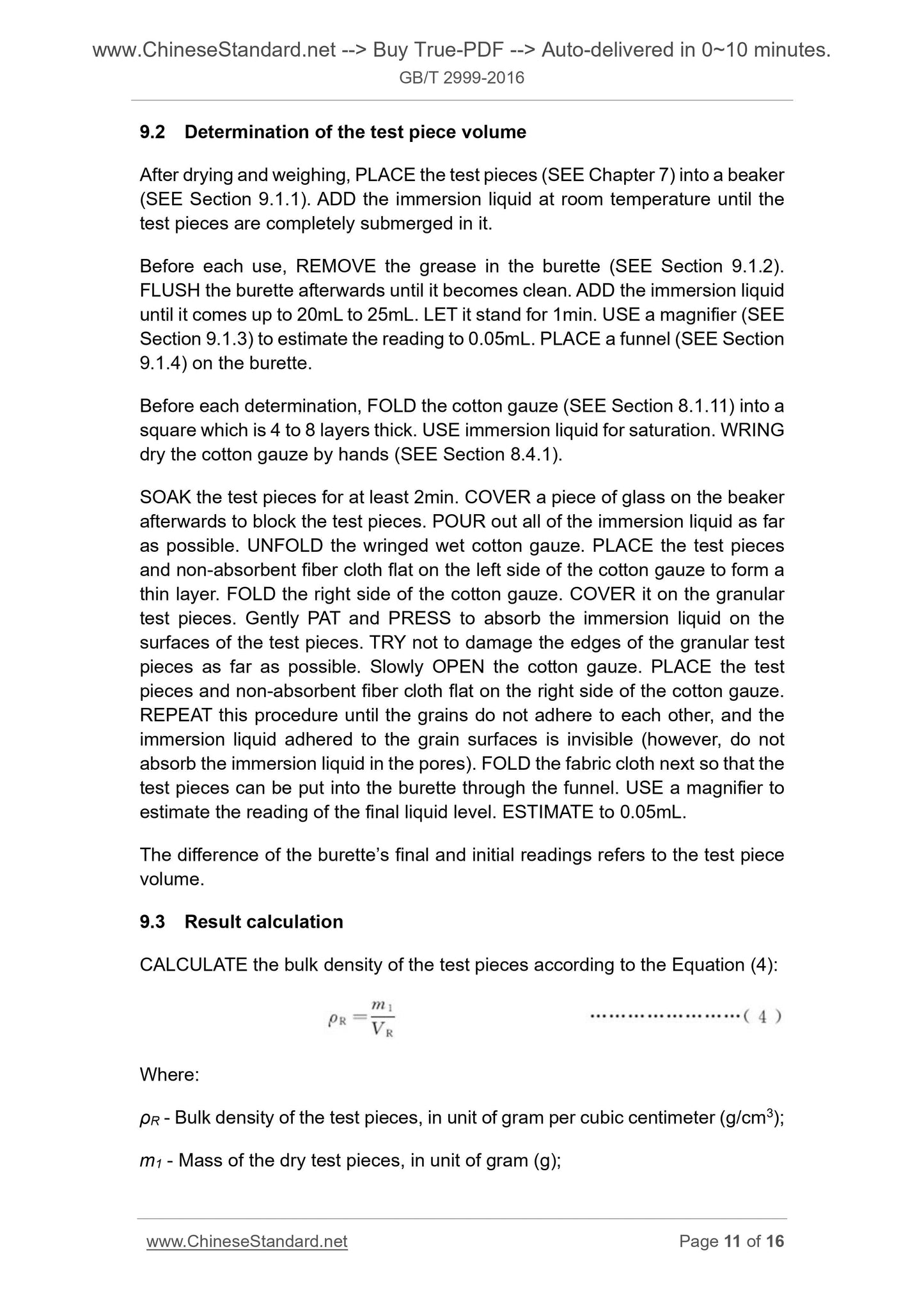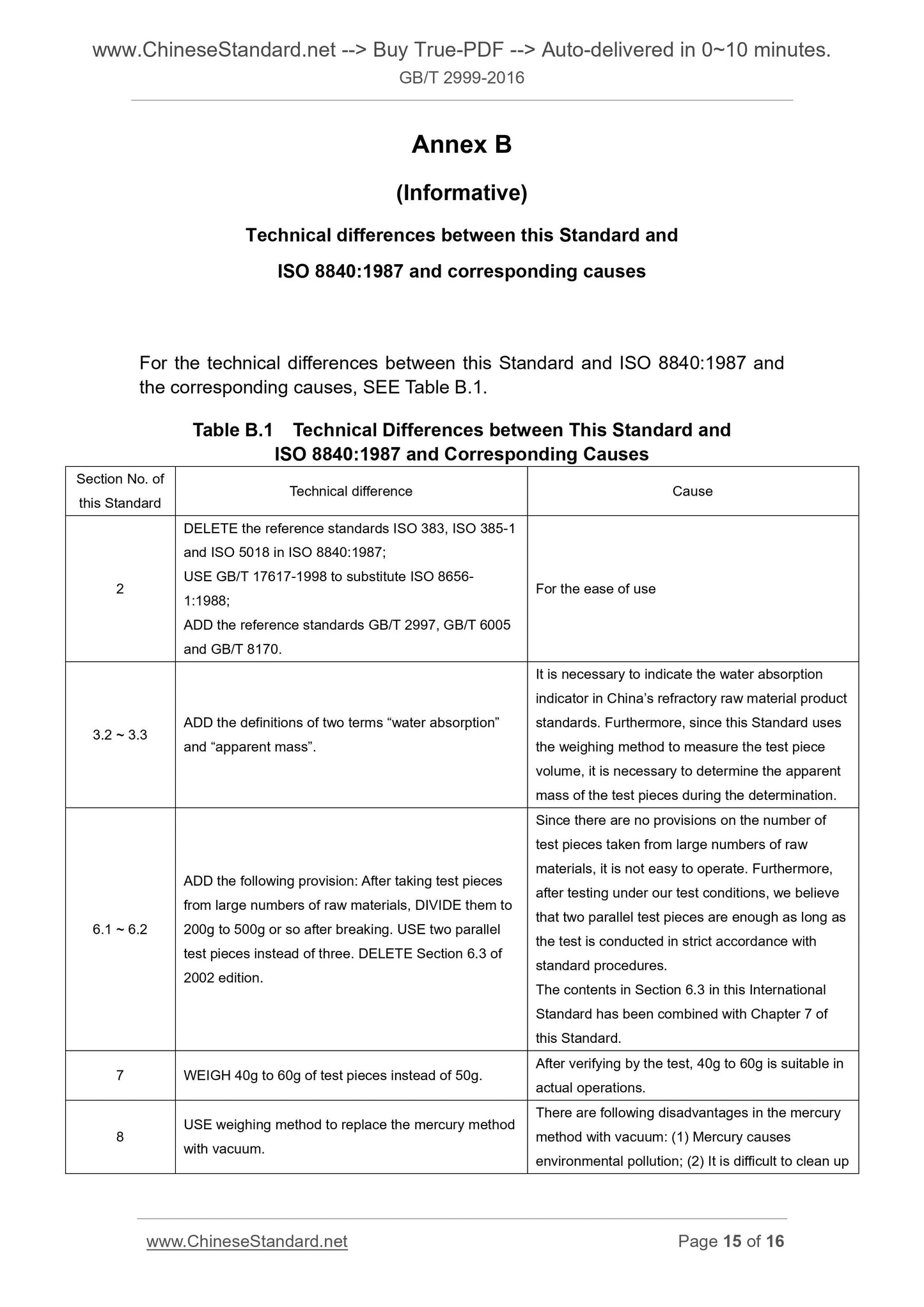PayPal, credit cards. Download editable-PDF & invoice in 1 second!
GB/T 2999-2016 English PDF (GBT2999-2016)
GB/T 2999-2016 English PDF (GBT2999-2016)
Precio habitual
$90.00 USD
Precio habitual
Precio de oferta
$90.00 USD
Precio unitario
/
por
Los gastos de envío se calculan en la pantalla de pago.
No se pudo cargar la disponibilidad de retiro
Delivery: 3 seconds. Download true-PDF + Invoice.
Get QUOTATION in 1-minute: Click GB/T 2999-2016
Historical versions: GB/T 2999-2016
Preview True-PDF (Reload/Scroll if blank)
GB/T 2999-2016: Refractory materials -- Determination of bulk density of granular materials
GB/T 2999-2016
GB
NATIONAL STANDARD OF THE
PEOPLE’S REPUBLIC OF CHINA
ICS 81.080
Q 40
Replacing GB/T 2999-2002
Refractory materials - Determination of
bulk density of granular materials
[ISO 8840.1987, Refractory materials - Determination of bulk density of
granular materials (grain density), MOD]
ISSUED ON. AUGUST 29, 2016
IMPLEMENTED ON. JULY 1, 2017
Issued by. General Administration of Quality Supervision, Inspection and
Quarantine of the People’s Republic of China;
Standardization Administration of the People’s Republic of
China.
Table of Contents
Foreword ... 3
1 Scope ... 5
2 Normative references ... 5
3 Terms and definitions ... 6
4 Principle... 6
5 Sampling ... 6
6 Test pieces ... 7
7 Determination of the mass of dry test pieces (m1) ... 7
8 Determination of the test piece volume - Method 1. Weighing method ... 7
9 Determination of the test piece volume - Method 2. Burette method ... 10
10 Rounding off for numerical values ... 12
11 Permissible error ... 12
12 Test report ... 12
Annex A (Informative) Contrast between the section numbers of
this Standard and ISO 8840.1987 ... 14
Annex B (Informative) Technical differences between this Standard and
ISO 8840.1987 and corresponding causes ... 15
Foreword
This Standard was drafted in accordance with the rules given in GB/T 1.1-2009.
This Standard replaces GB/T 2999-2002 Refractory materials - Determination
of bulk density of granular materials. Compared with GB/T 2999-2002, the
major content changes are as follows.
— MODIFY the relevant contents in normative references (SEE Chapter 2
of this Standard, Chapter 2 of 2002 edition);
— MODIFY the method of wiping the immersion liquid on the surfaces of
saturated test pieces (SEE Section 8.4.2 of this Standard, Section 8.4.2
of 2002 edition);
— DELETE the Annex A (SEE Annex A of 2002 edition).
This Standard was redrafted by reference to ISO 8840.1987 Refractory
materials - Determination of bulk density of granular materials (grain density)
after modification.
Compared with ISO 8840.1987, this Standard has made many structural
adjustments. The contrast table for the section numbers of this Standard and
ISO 8840.1987 is listed in Annex A.
There are technical differences between this Standard and ISO 8840.1987. For
the list of technical differences between this Standard and ISO 8840.1987 and
corresponding causes, SEE Annex B.
Some of the elements of this document may be the subject of patent rights. The
issuing authorities of this document shall not be held responsible for identifying
any or all such patent rights.
This Standard was proposed by and shall be under the jurisdiction of the
National Technical Committee for Standardization of Refractory Materials
(SAC/TC 193).
Main drafting organizations of this Standard. Central Research Institute of
Building and Construction Co., Ltd, Jiaozuo Jinxin Hengtuo High-temperature
Materials Co., Ltd, and Luoyang Institute of Science and Technology.
Main drafters of this Standard. Tian Zhihong, Zhang Xiuhua, Huang Jiangwen,
Wang Li, Mei Minghua, Xue Hongyan, Tian Jingjing, Yang Jing, Liu Xiang and
Sun Lijun.
The previous released editions substituted by this Standard are as follows.
Refractory materials - Determination of bulk
density of granular materials
1 Scope
This Standard specifies two methods for the determination of the bulk density
of granular refractory materials (grain density) with a grain size of larger than
2mm.
— Method 1. Weighing method;
— Method 2. Burette method.
Method 1 is intended as the referee method.
Depending on the nature of the material tested, the two methods may give
different results. Any statement of the value of a bulk density shall therefore be
accompanied by an indication of the method used or to be used in case of
dispute. The same method shall be used for the determination of the volume of
the sample, for selecting and preparing the sample, for calculating the bulk
density and for presenting the test report.
This Standard is applicable to the determination of the bulk density, water
absorption and apparent porosity of granular refractory materials.
2 Normative references
The following documents are essential to the application of this document. For
dated references, only the editions with the dates indicated are applicable to
this document. For undated references, only the latest editions (including all the
amendments) are applicable to this document.
GB/T 2997 Test method for bulk density, apparent porosity and true porosity
of dense shaped refractory products
GB/T 6005 Test sieves - Metal wire cloth, perforated metal plate and
electroformed sheet - Nominal sizes of openings
GB/T 8170 Rules of rounding off for numerical values and expression and
judgement of limiting values
8.1.5 Non-absorbent fiber cloth, such as polyester fiber cloth, nylon fiber cloth,
etc.
8.1.6 Vessel.
8.1.7 Vacuum equipment. It can decrease the absolute pressure to not greater
than 2,500MPa, and shall also be able to measure the absolute pressure value.
8.1.8 Immersion liquid. tap water or kerosene.
8.1.9 Mesh basket. It refers to the mesh basket with a handle, which is made
of sieve with a pore diameter of 1mm.
8.1.10 Vessel with an overflow pipe.
8.1.11 Cotton gauze. The dimension is about 60cm × 60cm.
8.1.12 Weighing bottle. with a diameter of 60mm and a height of 30mm.
8.1.13 Hydrostatic balance or hydrometer. with a division value of 0.001 g/cm3.
8.2 Test piece immersion
After weighing, carefully PLACE the test pieces on a piece of non-absorbent
fiber cloth (SEE Section 8.1.5). USE a string to wrap them firmly. PLACE in a
vessel (SEE Section 8.1.6). PLACE the vessel in the vacuum equipment (SEE
Section 8.1.7). VACUUM until the absolute pressure is less than 2,500MPa.
KEEP the test pieces at this degree of vacuum for 5min. Slowly INJECT the
immersion liquid (SEE Section 8.1.8) for absorption of test pieces within 5min,
until the test pieces are completely immersed. KEEP vacuuming for 5min.
STOP air exhaust. TAKE out the vessel. LET it stand in air, until the liquid inside
comes up to room temperature.
8.3 Determination of the apparent mass of saturated test pieces (m2)
HANG the mesh basket (SEE Section 8.1.9) on the balance hook so that the
mesh basket can completely immerse into the liquid. ZERO the balance. TAKE
out the mesh basket for standby application. OPEN the wrapping cloth.
Carefully SCRAPE the saturated test pieces into the mesh basket. Rapidly
MOVE the mesh basket into the immersion liquid in the vessel with an overflow
pipe. After the test pieces completely immerse into the immersion liquid, MOVE
the mesh basket up and down for several times so that the residual bubbles
can escape. HANG the mesh basket on the balance hook for weighing.
ACCURATE to 0.01g.
8.4 Determination of the mass of saturated test pieces (m3)
9.2 Determination of the test piece volume
After drying and weighing, PLACE the test pieces (SEE Chapter 7) into a beaker
(SEE Section 9.1.1). ADD the immersion liquid at room temperature until the
test pieces are completely submerged in it.
Before each use, REMOVE the grease in the burette (SEE Section 9.1.2).
FLUSH the burette afterwards until it becomes clean. ADD the immersion liquid
until it comes up to 20mL to 25mL. LET it stand for 1min. USE a magnifier (SEE
Section 9.1.3) to estimate the readi...
Get QUOTATION in 1-minute: Click GB/T 2999-2016
Historical versions: GB/T 2999-2016
Preview True-PDF (Reload/Scroll if blank)
GB/T 2999-2016: Refractory materials -- Determination of bulk density of granular materials
GB/T 2999-2016
GB
NATIONAL STANDARD OF THE
PEOPLE’S REPUBLIC OF CHINA
ICS 81.080
Q 40
Replacing GB/T 2999-2002
Refractory materials - Determination of
bulk density of granular materials
[ISO 8840.1987, Refractory materials - Determination of bulk density of
granular materials (grain density), MOD]
ISSUED ON. AUGUST 29, 2016
IMPLEMENTED ON. JULY 1, 2017
Issued by. General Administration of Quality Supervision, Inspection and
Quarantine of the People’s Republic of China;
Standardization Administration of the People’s Republic of
China.
Table of Contents
Foreword ... 3
1 Scope ... 5
2 Normative references ... 5
3 Terms and definitions ... 6
4 Principle... 6
5 Sampling ... 6
6 Test pieces ... 7
7 Determination of the mass of dry test pieces (m1) ... 7
8 Determination of the test piece volume - Method 1. Weighing method ... 7
9 Determination of the test piece volume - Method 2. Burette method ... 10
10 Rounding off for numerical values ... 12
11 Permissible error ... 12
12 Test report ... 12
Annex A (Informative) Contrast between the section numbers of
this Standard and ISO 8840.1987 ... 14
Annex B (Informative) Technical differences between this Standard and
ISO 8840.1987 and corresponding causes ... 15
Foreword
This Standard was drafted in accordance with the rules given in GB/T 1.1-2009.
This Standard replaces GB/T 2999-2002 Refractory materials - Determination
of bulk density of granular materials. Compared with GB/T 2999-2002, the
major content changes are as follows.
— MODIFY the relevant contents in normative references (SEE Chapter 2
of this Standard, Chapter 2 of 2002 edition);
— MODIFY the method of wiping the immersion liquid on the surfaces of
saturated test pieces (SEE Section 8.4.2 of this Standard, Section 8.4.2
of 2002 edition);
— DELETE the Annex A (SEE Annex A of 2002 edition).
This Standard was redrafted by reference to ISO 8840.1987 Refractory
materials - Determination of bulk density of granular materials (grain density)
after modification.
Compared with ISO 8840.1987, this Standard has made many structural
adjustments. The contrast table for the section numbers of this Standard and
ISO 8840.1987 is listed in Annex A.
There are technical differences between this Standard and ISO 8840.1987. For
the list of technical differences between this Standard and ISO 8840.1987 and
corresponding causes, SEE Annex B.
Some of the elements of this document may be the subject of patent rights. The
issuing authorities of this document shall not be held responsible for identifying
any or all such patent rights.
This Standard was proposed by and shall be under the jurisdiction of the
National Technical Committee for Standardization of Refractory Materials
(SAC/TC 193).
Main drafting organizations of this Standard. Central Research Institute of
Building and Construction Co., Ltd, Jiaozuo Jinxin Hengtuo High-temperature
Materials Co., Ltd, and Luoyang Institute of Science and Technology.
Main drafters of this Standard. Tian Zhihong, Zhang Xiuhua, Huang Jiangwen,
Wang Li, Mei Minghua, Xue Hongyan, Tian Jingjing, Yang Jing, Liu Xiang and
Sun Lijun.
The previous released editions substituted by this Standard are as follows.
Refractory materials - Determination of bulk
density of granular materials
1 Scope
This Standard specifies two methods for the determination of the bulk density
of granular refractory materials (grain density) with a grain size of larger than
2mm.
— Method 1. Weighing method;
— Method 2. Burette method.
Method 1 is intended as the referee method.
Depending on the nature of the material tested, the two methods may give
different results. Any statement of the value of a bulk density shall therefore be
accompanied by an indication of the method used or to be used in case of
dispute. The same method shall be used for the determination of the volume of
the sample, for selecting and preparing the sample, for calculating the bulk
density and for presenting the test report.
This Standard is applicable to the determination of the bulk density, water
absorption and apparent porosity of granular refractory materials.
2 Normative references
The following documents are essential to the application of this document. For
dated references, only the editions with the dates indicated are applicable to
this document. For undated references, only the latest editions (including all the
amendments) are applicable to this document.
GB/T 2997 Test method for bulk density, apparent porosity and true porosity
of dense shaped refractory products
GB/T 6005 Test sieves - Metal wire cloth, perforated metal plate and
electroformed sheet - Nominal sizes of openings
GB/T 8170 Rules of rounding off for numerical values and expression and
judgement of limiting values
8.1.5 Non-absorbent fiber cloth, such as polyester fiber cloth, nylon fiber cloth,
etc.
8.1.6 Vessel.
8.1.7 Vacuum equipment. It can decrease the absolute pressure to not greater
than 2,500MPa, and shall also be able to measure the absolute pressure value.
8.1.8 Immersion liquid. tap water or kerosene.
8.1.9 Mesh basket. It refers to the mesh basket with a handle, which is made
of sieve with a pore diameter of 1mm.
8.1.10 Vessel with an overflow pipe.
8.1.11 Cotton gauze. The dimension is about 60cm × 60cm.
8.1.12 Weighing bottle. with a diameter of 60mm and a height of 30mm.
8.1.13 Hydrostatic balance or hydrometer. with a division value of 0.001 g/cm3.
8.2 Test piece immersion
After weighing, carefully PLACE the test pieces on a piece of non-absorbent
fiber cloth (SEE Section 8.1.5). USE a string to wrap them firmly. PLACE in a
vessel (SEE Section 8.1.6). PLACE the vessel in the vacuum equipment (SEE
Section 8.1.7). VACUUM until the absolute pressure is less than 2,500MPa.
KEEP the test pieces at this degree of vacuum for 5min. Slowly INJECT the
immersion liquid (SEE Section 8.1.8) for absorption of test pieces within 5min,
until the test pieces are completely immersed. KEEP vacuuming for 5min.
STOP air exhaust. TAKE out the vessel. LET it stand in air, until the liquid inside
comes up to room temperature.
8.3 Determination of the apparent mass of saturated test pieces (m2)
HANG the mesh basket (SEE Section 8.1.9) on the balance hook so that the
mesh basket can completely immerse into the liquid. ZERO the balance. TAKE
out the mesh basket for standby application. OPEN the wrapping cloth.
Carefully SCRAPE the saturated test pieces into the mesh basket. Rapidly
MOVE the mesh basket into the immersion liquid in the vessel with an overflow
pipe. After the test pieces completely immerse into the immersion liquid, MOVE
the mesh basket up and down for several times so that the residual bubbles
can escape. HANG the mesh basket on the balance hook for weighing.
ACCURATE to 0.01g.
8.4 Determination of the mass of saturated test pieces (m3)
9.2 Determination of the test piece volume
After drying and weighing, PLACE the test pieces (SEE Chapter 7) into a beaker
(SEE Section 9.1.1). ADD the immersion liquid at room temperature until the
test pieces are completely submerged in it.
Before each use, REMOVE the grease in the burette (SEE Section 9.1.2).
FLUSH the burette afterwards until it becomes clean. ADD the immersion liquid
until it comes up to 20mL to 25mL. LET it stand for 1min. USE a magnifier (SEE
Section 9.1.3) to estimate the readi...
Share
